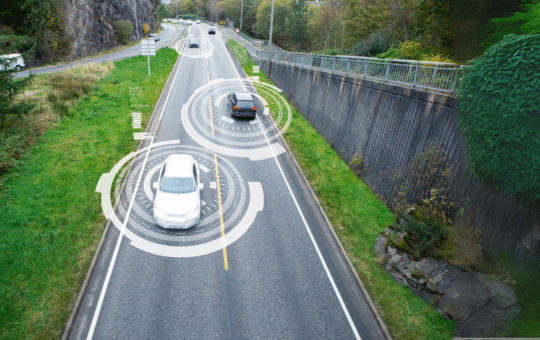
Level 3 Certification in Vehicle Safety Systems and Crash Testing
- Gain a solid understanding of vehicle safety systems and their role in accident prevention and protection.
- Learn about crash testing standards, methodologies, and the technologies involved in evaluating vehicle safety.
- Develop expertise in understanding the key safety features in modern vehicles, including airbags, seatbelts, and active safety systems.
- Enhance career prospects in the automotive industry, focusing on safety systems development, testing, and vehicle design.
- Understand the core components of vehicle safety systems, including passive and active safety features.
- Learn about crash testing methodologies and the criteria used to evaluate vehicle safety.
- Gain insights into the regulatory standards and global crash test ratings for vehicles.
- Develop knowledge on the importance of safety in vehicle design and its impact on consumer protection and industry standards.
- Introduction to Vehicle Safety Systems
- Overview of passive safety features such as airbags, seatbelts, and crumple zones.
- Active safety technologies like electronic stability control (ESC), lane departure warning, and automatic emergency braking (AEB).
- Crash Testing Methodologies
- Introduction to the different types of crash tests, including frontal, side-impact, and rollover tests.
- How crash test data is used to improve vehicle design and safety features.
- Global Safety Standards and Regulations
- Understanding the global standards for vehicle safety, including NCAP (New Car Assessment Program) and Euro NCAP.
- Role of regulatory bodies in setting crashworthiness and safety standards.
- Technologies for Improving Vehicle Safety
- Innovations in crash-avoidance technologies, such as autonomous emergency braking and adaptive cruise control.
- Role of advanced materials and structural design in improving crashworthiness.
- Crash Test Data Interpretation and Analysis
- How crash test results are interpreted and used by manufacturers and regulatory agencies.
- The importance of data analysis in developing safer vehicles.
- Progress to higher-level qualifications in automotive safety engineering, such as Level 4 or Level 5.
- Pursue careers in vehicle safety testing, automotive design, or regulatory compliance within the automotive industry.
- Work with automotive manufacturers, safety organizations, and research institutions focusing on vehicle safety innovation and crash testing.
- Cutting-Edge Curriculum: Learn about the latest advancements in vehicle safety systems and testing.
- Industry-Relevant Skills: Acquire knowledge that is crucial for working in vehicle safety, testing, and design.
- Expert Instructors: Learn from instructors with real-world experience in automotive safety engineering and crash testing.
- Globally Recognized Certification: Boost your qualifications with a certification that is recognized across the automotive industry.
Study Units
- Introduction to Vehicle Safety Systems
- Overview of passive safety features such as airbags, seatbelts, and crumple zones.
- Active safety technologies like electronic stability control (ESC), lane departure warning, and automatic emergency braking (AEB).
- Crash Testing Methodologies
- Introduction to the different types of crash tests, including frontal, side-impact, and rollover tests.
- How crash test data is used to improve vehicle design and safety features.
- Global Safety Standards and Regulations
- Understanding the global standards for vehicle safety, including NCAP (New Car Assessment Program) and Euro NCAP.
- Role of regulatory bodies in setting crashworthiness and safety standards.
- Technologies for Improving Vehicle Safety
- Innovations in crash-avoidance technologies, such as autonomous emergency braking and adaptive cruise control.
- Role of advanced materials and structural design in improving crashworthiness.
- Crash Test Data Interpretation and Analysis
- How crash test results are interpreted and used by manufacturers and regulatory agencies.
- The importance of data analysis in developing safer vehicles.
Upon completing this certification, learners will:
- Understand the core components of vehicle safety systems, including passive and active safety features.
- Learn about crash testing methodologies and the criteria used to evaluate vehicle safety.
- Gain insights into the regulatory standards and global crash test ratings for vehicles.
- Develop knowledge on the importance of safety in vehicle design and its impact on consumer protection and industry standards.
This certification is designed for individuals who are keen to specialize in vehicle safety systems and crash testing. It is ideal for:
Automotive Safety Engineers
Engineers involved in the development, testing, and optimization of vehicle safety features, including passive and active safety systems.
Vehicle Designers and Developers
Professionals working in vehicle design who need to understand how to incorporate safety features to meet regulatory standards and enhance crashworthiness.
Crash Test Analysts
Individuals working in crash testing and safety evaluations, who want to deepen their expertise in interpreting crash test data and improving vehicle safety.
Regulatory Compliance Specialists
Professionals focused on ensuring vehicles meet global safety standards and crash test regulations.
Automotive Technicians and Mechanics
Technicians specializing in vehicle safety systems, airbags, seatbelts, and active safety technologies who want to advance their knowledge of vehicle crash testing.
Research and Development Professionals
Individuals in the R&D sector of automotive safety, looking to enhance their understanding of safety systems and crash test methodologies.
Students and Apprentices in Automotive Engineering
Aspiring automotive engineers or safety professionals who are looking to gain specialized knowledge in vehicle safety technologies and crash testing.
Our assessment process is designed to ensure every learner achieves the required level of knowledge, skills, and understanding outlined in each course unit.
Purpose of Assessment
Assessment helps measure how well a learner has met the learning outcomes. It ensures consistency, quality, and fairness across all learners.
What Learners Need to Do
Learners must provide clear evidence that shows they have met all the learning outcomes and assessment criteria for each unit. This evidence can take different forms depending on the course and type of learning.
Types of Acceptable Evidence
Assignments, reports, or projects
Worksheets or written tasks
Portfolios of practical work
Answers to oral or written questions
Test or exam papers
Understanding the Structure
Learning outcomes explain what learners should know, understand, or be able to do.
Assessment criteria set the standard learners must meet to achieve each learning outcome.
Assessment Guidelines
All assessment must be authentic, current, and relevant to the unit.
Evidence must match each assessment criterion clearly.
Plagiarism or copied work is not accepted.
All learners must complete assessments within the given timelines.
Where applicable, assessments may be reviewed or verified by internal or external quality assurers.
Full learning outcomes and assessment criteria for each qualification are available from page 8 of the course handbook.
Top Courses
No results found.
Related Courses
Let's Get in touch
Deleting Course Review
Course Access
This course is password protected. To access it please enter your password below:



